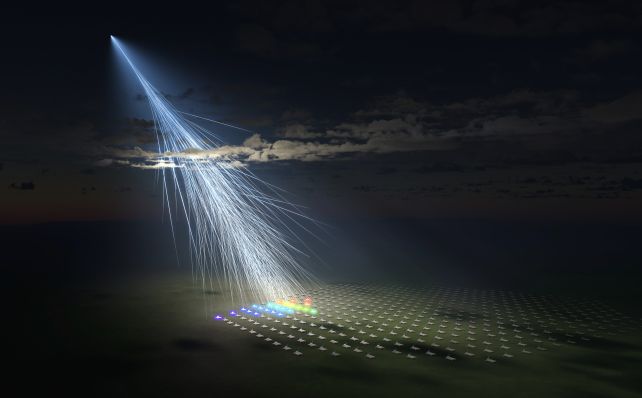In a groundbreaking discovery that has left astrophysicists astounded, a cosmic ray with an energy exceeding 240 exa-electron volts, named Amaterasu, struck Earth’s atmosphere.

This event is second only to the 1991 detection of the Oh-My-God particle, which had an energy of 320 exa-electron volts. The origin of these ultra-high-energy cosmic rays remains an enigma, challenging our current understanding of astrophysical phenomena.
The Enigma of Cosmic Rays
Cosmic rays, primarily composed of atomic nuclei and sub-nuclear particles like protons and electrons, travel through the universe at near-light speeds, carrying more energy than theoretically expected. While lower-energy cosmic rays are understood to originate from stars and supernovas, the sources of these ultra-high-energy rays are elusive. Our atmosphere shields us from direct impact, but when these rays collide with atmospheric particles, they create a cascade of secondary particles detectable by observatories on Earth.
The Telescope Array’s Discovery
The Telescope Array, an extensive observatory covering 700 square kilometers, detected the Amaterasu particle on May 27, 2021. This discovery, made using advanced detection techniques, confirmed that such high-energy cosmic events are not anomalies but real astrophysical occurrences. The naming of the particle after the Shinto sun goddess reflects its extraordinary nature.

The Challenge of Tracing Origins
One of the most baffling aspects of these cosmic rays is their untraceable origins. Theoretically, their high energy should allow for a clear path back to their source. However, both the Oh-My-God particle and Amaterasu seem to originate from regions in space that lack sufficiently energetic phenomena to produce them. This discrepancy suggests unknown mechanisms or sources at play in the cosmos.
The Greisen-Zatsepin-Kuzmin Limit
Ultra-high-energy cosmic rays like Amaterasu pose a significant puzzle due to the Greisen-Zatsepin-Kuzmin (GZK) limit, an estimated maximum energy threshold for cosmic rays traveling long distances. Amaterasu’s energy exceeds this limit, indicating that its source should be within 160 million light-years. Yet, no known astrophysical event within this range seems capable of generating such energy.
The Void Conundrum
Tracing Amaterasu’s trajectory leads back to a cosmic void, a relatively empty space between galaxy clusters. This finding intensifies the mystery, as such voids are unlikely to house phenomena capable of producing ultra-high-energy cosmic rays. This gap in understanding points to potential new astrophysical phenomena or previously unrecognized capabilities of cosmic magnetic fields.
The Future of Cosmic Ray Research
The detection of Amaterasu opens new avenues in astrophysics, prompting theories ranging from unknown particle acceleration mechanisms to novel cosmic phenomena. Researchers are considering various possibilities, including spacetime defects or cosmic string collisions, as potential explanations. This discovery underscores the vastness of our universe’s mysteries and the continuous evolution of our understanding of cosmic events.
In conclusion, the detection of the Amaterasu cosmic ray represents a significant milestone in astrophysics, challenging existing theories and sparking a quest for new explanations. As scientists delve deeper into this mystery, we stand on the brink of potentially groundbreaking discoveries that could reshape our comprehension of the universe and its myriad phenomena.
Reference(s): News Release

